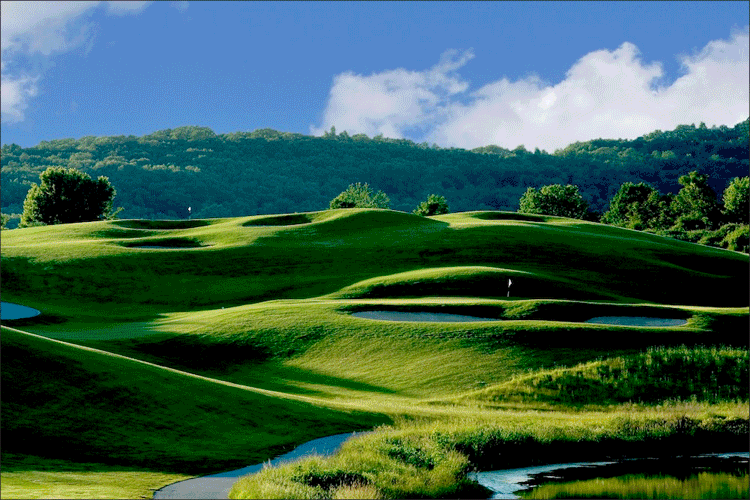A fortnight’s time sees the start of the second major golf tournament of the year, as The US Open gets underway at Erin Hills in Erin, Wisconsin. It’s an event that has been kind to British players over the last few years, and now carries the biggest cash prize in the history of golf majors.

This will be the 117th edition of the tournament, and will be held in the Midwest at the Erin Hills Club in Erin, Wisconsin – the first time it has been played there – the 52nd different course to be used.
Last year’s Champion was American Dustin Johnson, who finished 3 shots ahead of his nearest challengers en route to becoming the number 1 ranked player in the world.
The US Open however has been fairly good to the British players as of late, with 3 different winners in the last 7 years, with those being Graeme McDowell in 2010, Rory Mcllroy in 2011, and Justin Rose in 2013.
There should be a 156 strong field of competitors taking to the fairways and greens with the winner of the tournament picking up the Open Trophy and the biggest amount ever played for at a major - a cool $1.8 million, which is stark contrast to the first ever tournament in 1895 when Englishman Horace Rawlins took home a prize of $150 and a $50 gold medal.
The U.S. Open is staged at a variety of courses, set up in such a way that scoring is very difficult with a premium placed on accurate driving. U.S. Open play is characterised by tight scoring – in fact it is not unusual for the winner of the 4 day event to actually end up over par.
The best British hopes this time around rest with World number 2 Rory McIlroy, number 11 Justin Rose, and number 14 Paul Casey.
Erin Hills is a course like no other — only created a mere 11 years ago it is routed over the kettle moraine areas left by glaciers, surrounded by wetlands and a river, with ground that consists of glacial till of varied composition of sand and small rock. In an unconventional decision for a course in Wisconsin, the architects used fine fescue for the fairways to emphasize the natural contours of the property and provide a firm-playing surface that plays shorter than it’s length on the scorecard.
The course was designed to accommodate the U.S. Open, in terms of both the challenge to the players and the logistics of the spectators and related support structure. This mix of traditional and modern elements as well as a championship test will leave many golfers with the feeling that they’ve never played anywhere like Erin Hills.

The holes of Erin Hills.
Out
1. 608 yards Par 5
The opening hole skirts the wetland, with the fairway tilted from right to left towards it. This hole features the one green that is best approached along the ground. The cluster of bunkers dug into the right hillside some 50 yards from the green function, in effect, as greenside bunkers for those trying to reach the green in two.
2. 358 yards Par 4
The 2nd is a classic strategic hole where the player who is confident enough to venture towards the unseen (the left side of the fairway) is rewarded with a view of the green for his pitch. However, the smallest green on the course ensures that the challenge is far from over after a good tee shot.
3. 476 yards Par 4
The first long par 4 on the course, the 3rd completes a varied opening trio of holes. The wetland on the left and bunkers challenge the tee shot, and the central bunker can deceive golfers into under-clubbing with the approach. Consider the different backdrops for the first three greens: the 1st green jutting out into a wetland, the 2nd green with the openness of the 3rd hole beyond and the 3rd green set against a hillside.
4. 439 yards Par 4
The 4th could be the most demanding hole on the course. The fairway is flanked by a hillside of healthy rough on the left and a menacing bunker that juts into the fairway from the right. The large central bunkers will force many players who miss the fairway to leave themselves a long third shot. With the shallow green, the front bunker and the wetlands just beyond the green, the approach is the most demanding iron a player will be asked to play all day.
5. 505 yards Par 4
With its fairway flowing over the natural contours and the surrounding openness, the 5th hole perhaps best captures the character of Erin Hills. In preparation for the 2011 U.S. Amateur, the rough left of the front-left greenside bunker was reduced to fairway height to allow a player to bounce in his approach shot from the left.
6. 237 yards Par 3
With its large green and apparent lack of defenses surrounding it, the 6th at first seems to be a breather. While it is true that a score of worse than 4 is unlikely, a 3 is well earned. With the westerly prevailing wind from behind and a false front followed by a green sloping away from the player, getting close to a hole location on the front half of the green is especially challenging.
7. 607 yards Par 5
This rolling three-shotter plays past the bell that was used to give the all clear for the former Dell Hole (RIP). Three bunkers in front and on the left visually dominate the approach, but the false front on the right is perhaps the bigger challenge. As with several greens at Erin Hills (e.g., the 3rd, 10th and 14th), the 7th green steps down from side-to-side, a refreshing change from two-level greens that have all-too-predictable front and back levels.
8. 492 yards Par 4
With its right-to-left dogleg and left-to-right slope of the fairway, the 8th is the tee shot where the player who has the ability to shape his shots at will (in this case from right-to-left) holds the biggest advantage at Erin Hills. With the front bunkers and shallow green, the approach favors the player who can bring the ball in with a high trajectory, although the rise at the back of the left half of the green provides a helpful backstop.
9. 165 yards Par 3
After a series of big holes, the short and precise 9th comes as a jolt to the player. With the elevated tee and exposure to the wind, club selection is a challenge. The green is a bit of a mirror image Redan, with its angle and slope from left-to-right. The treacherous back-left bunker is key as it is not visible from the tee and many players whose tee shots looked good in the air walk away with 5 or worse after finding this bunker.
In
10. 504 yards Par 4
Despite the blind tee shot, the expansive fairway encourages the player to open his shoulders off the tee. To give himself a reasonable approach to this shallow green that is heavily bunkered on the right, the player needs to hit his tee shot down the hill. The closely mown area right and behind the green can be used to work the ball with a longer club towards the hole, though.
11. 403 yards Par 4
After a number of demanding holes, the 11th provides a bit of a breather as the fairway can gather tee shots and the approach is usually just a pitch. However, care still needs to be taken with the small green that slopes from left to right. The back nine presents a variety of challenges and not just the stereotypical long par 4s seen on most championship courses.
12. 464 yards Par 4
With its wild topography and partially hidden green, the 12th hole showcases the minimalist approach the architects took to build Erin Hills. The tee shot must reach the plateau to afford the player a reasonable approach to the green set in a hollow. With a rare wind from the east or for the long players, the tee shot that flirts with the right side can go down the hill and leave just a pitch.
13. 215 yards Par 3
The 13th is a rendition of the classic hill-to-hill par 3. In this case, the player’s eyes are drawn to the expansive bunker left of the green, to which a swale in the left side of the green directs balls. However, the fall-away short, right and behind the green cannot be ignored or looked at as safe places to miss the green.
14. 613 yards Par 5
The 14th is a gambling par 5 where fortune does in fact favor the bold. Here the player who lays up faces an awkward third, where the pitch is nearly blind to a green that runs away from that angle. The player who goes for the green with his second shot certainly faces his share of trouble, though, such as the thick rough short of the green, the severe false front of the green, a cavernous front-right bunker and a river right of the green.
15. 370 yards Par 4
The 15th presents the player several options – to lay up short of all the bunkers, to place the tee shot in the middle of the bunkers or to have a go at the green itself. The sharp drop-off right of the green encourages the player to favor the center or left of the green with his pitch, but the spine that extends from the hillside into the green provides a challenging two-putt for a player on the wrong side of the green.
16. 200 yards Par 3
This narrow, slightly angled green is nestled against the hillside on its left. At first glance one might think that left is a good place to miss the green in that the hill should kick balls down towards the green. However, there are bunkers at the base of that hill that the golfer cannot see from the tee that will catch a ball trying to find the green off the hillside.
17. 481 yards Par 4
With the green tucked behind a hill on the left, a tee shot down the right provides the golfer with a clear view of the green while one down the left leaves a partially blind approach. Like the 1st, the 17th hole does not need greenside bunkering as the natural terrain provides plenty of challenge.
18. 663 yards Par 5
Erin Hills closes with a long par 5 that lines up with Holy Hill in the distance. The player must fight his natural tendency to play directly towards the green and must force himself to play his second shot well to the right. The cluster of bunkers short of the green visually dominates the approach, but the player needs to take care not to miss the green to the left, where the closely mown area will propel the ball well away from the green.
Total yards = 7800 (Par 72)
More than 35,000 people are expected to attend each day at Erin Hills, which is a rarity in the fact that it is a public access golf course.
For more information please head on over to here and here.
